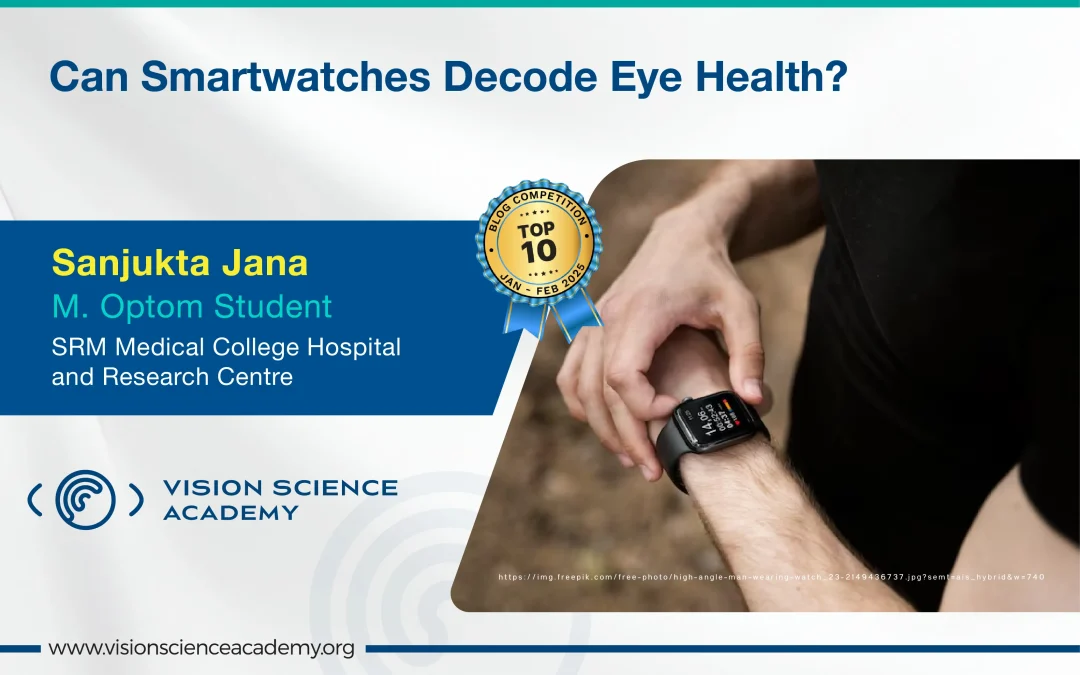Sanjukta Jana, B.Optom, M.Optom. Student,
SRM Medical College Hospital and Research Centre, Chennai, India
Consumer smartwatches have the potential to support health and wellness. Since 2014, consumer smartwatches have supported healthcare research immensely. A smartwatch is not merely a timekeeping device; instead, it is a wristwatch equipped with various sensors that enable diverse applications. Researchers have utilised smartwatches effectively for seizure detection, daily activity monitoring, heart rate analysis, and eating patterns via audio-based detections. (1)
The array of integrated sensors includes –
- Accelerometers (Measure vibration or rate of change of velocity)
- Gyroscope (Detects orientation or rotational tilt of an object)
- Contact sensors (send security alerts to the phone)
- Ambient light intensity sensors (Photodetectors sense light from the environment) (1)
Light myopia association
Vision experts have used various models of Actiwatch to analyse the association between light exposure and myopia. Research shows more time spent outdoors is strongly associated with less myopia. (2) To interpret the role of indoor and outdoor time on myopia progression, methods utilise subjective recall of time spent indoors versus outdoors, with or rely on objective capture of data using wearable devices with ambient light sensors. (3) The ambient light intensity sensors in smartwatches are used for objective measurement of light levels in the environment. (2) These are unobtrusive and easier to use than other light meter devices. (2) It is more precise than subjective methods to measure light exposure such as weekly diaries or questionnaire forms. (2)
Eye Rubbing Detection and Prevention
Keratoconus is a progressive corneal ecstatic disorder. One of the risk factors includes frequent eye rubbing, which eventually leads to corneal thinning. Few artificial intelligence applications, when installed on a smartphone, leverage motion data using the gyroscope and accelerometer to identify eye rubbing behaviours. (4) Sensors are under investigation to improve results on the accurate detection of unconscious gestures and movement patterns. (5) The frequency and duration of eye duration are difficult to measure objectively, which hinders efforts to assess its impact on keratoconus and develop effective interventions. (5) To address this gap, the need for an objective method of eye-rubbing detection was evident. (5)
Blood Pressure Monitoring in Glaucoma Management
Blood pressure dysregulation can influence glaucoma progression. However, research evidence regarding this is multifaceted. (6) Smartwatches equipped with monitoring capabilities allow for home-based tracking, offering valuable data for managing this progressive ocular condition. (6) Studies have assessed the usability of such devices among glaucoma patients, highlighting their potential in routine monitoring. (6)

Chart 1: Role of Hypertension in Open-Angle Glaucoma
Flow chart is created by the author with reference from the following article:
Nislawati, R., Taufik Fadillah Zainal, A., Ismail, A., Waspodo, N., Kasim, F., & Gunawan, A. M. A. K.
(2021). Role of hypertension as a risk factor for open-angle glaucoma: a systematic review and
meta-analysis. BMJ open ophthalmology, 6(1), e000798.https://doi.org/10.1136/bmjophth-2021-000798
Connecting the Dots
Smart watches with sleep monitoring functionalities can help in early detection of obstructive sleep apnoea. Wrist-worn devices with blood glucose monitoring systems indirectly benefit diabetic patients. As a consequence, ocular conditions related to sleep apnea (These include floppy eyelid syndrome, non arteritic anterior ischemic optic neuropathy, central serous retinopathy, retinal vein occlusion, and glaucoma) and diabetes (DM can lead to several ocular complications such as diabetic retinopathy, diabetic papillopathy, glaucoma, cataract, and ocular surface diseases) may be prevented. (7,8)
Conclusion
Smartwatches offer transformative potential in optometry by enabling real-time monitoring and early detection, with significant scope for research to advance their role in vision care and ocular health.
References:
- Reeder, B., & David, A. (2016). Health at hand: A systematic review of smart watch uses for health and wellness. Journal of biomedical informatics, 63, 269-276.
- Shneor, E., Gordon-Shaag, A., Doron, R., Benoit, J. S., & Ostrin, L. A. (2024). Utility of the Actiwatch Spectrum Plus for detecting the outdoor environment and physical activity in children. Journal of Optometry, 17(1), 100483.
- Ye, B., Liu, K., Cao, S., Sankaridurg, P., Li, W., Luan, M., & He, X. (2019). Discrimination of indoor versus outdoor environmental state with machine learning algorithms in myopia observational studies. Journal of translational medicine, 17, 1-12.
- Drira I, Louja A, Sliman L, et al. Eye-Rubbing Detection Tool Using Artificial Intelligence on a Smartwatch in the Management of Keratoconus.
- Elahi, S., Mery, T., Panthier, C., Saad, A., Gatinel, D., & Alahi, A. (2024). Eye-Rubbing Detection Using a Smartwatch: A Feasibility Study Demonstrated High Accuracy With Machine Learning. Translational Vision Science & Technology, 13(9), 1-1.
- Bhanvadia, S. B., Brar, M. S., Delavar, A., Tavakoli, K., Radha Saseendrakumar, B., Weinreb, R. N., … & Baxter, S. L. (2022, October). Assessing usability of smartwatch digital health devices for home blood pressure monitoring among glaucoma patients. In Informatics (Vol. 9, No. 4, p. 79). MDPI.
- Santos, M., & Hofmann, R. J. (2017). Ocular manifestations of obstructive sleep apnea. Journal of Clinical Sleep Medicine, 13(11), 1345-1348.
- Sayin, N., Kara, N., & Pekel, G. (2015). Ocular complications of diabetes mellitus. World journal of diabetes, 6(1), 92.


Recent Comments